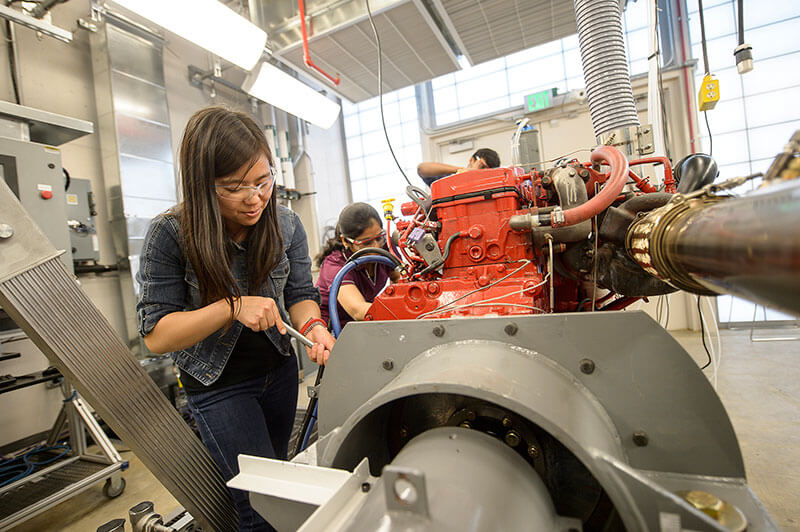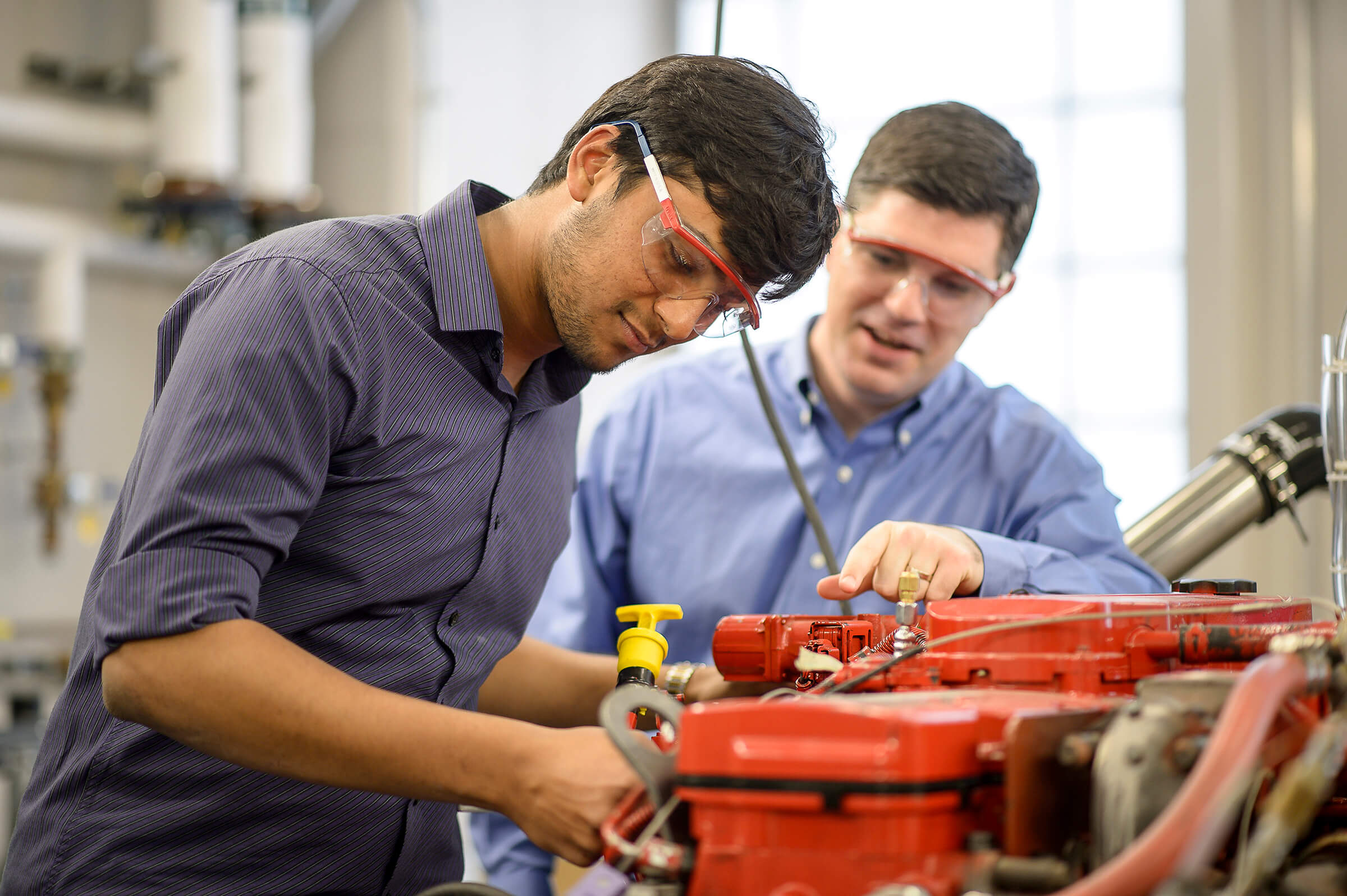January 11, 2017
Project focusing on heavy-duty trucks is part of national effort to reduce vehicle fuel consumption

Former Purdue graduate students Sylvia Lu, left, and Mayura Halbe work in the Cummins Power Laboratory at Purdue’s Ray W. Herrick Laboratories. (Purdue University photo/Charles Jischke)
WEST LAFAYETTE, Ind. - Purdue University is leading part of a national effort to reduce vehicle fuel consumption by 20 percent through automated systems that interconnect cars and trucks and the transportation infrastructure using sensors and online cloud technology.
The U.S. Department of Energy’s Advanced Research Projects Agency-Energy (ARPA-E) has announced up to $32 million in funding for 10 projects as part of its Next-Generation Energy Technologies for Connected and Autonomous On-Road Vehicles (NEXTCAR) program.
Purdue leads a project focusing on Class 8 trucks, namely tractor-trailers, and will work with team members Cummins Inc., Peloton Technology, Peterbilt Motors Co., the National Renewable Energy Laboratory and ZF TRW.
“This is the ideal marriage of the public and private sectors to the mutual benefit of both,” said Suresh Garimella, executive vice president for research and partnerships. “"We anticipate the result will be a commercial and environmental success."
 Purdue doctoral student Dheeraj Gosala, foreground, works on an engine. Looking on is Gregory Shaver, a Purdue professor of mechanical engineering who is leading part of a national effort to reduce vehicle fuel consumption by 20 percent. The research is funded through the U.S. Department of Energy’s Advanced Research Projects Agency-Energy. (Purdue University photo/Charles Jischke)
Download image
Purdue doctoral student Dheeraj Gosala, foreground, works on an engine. Looking on is Gregory Shaver, a Purdue professor of mechanical engineering who is leading part of a national effort to reduce vehicle fuel consumption by 20 percent. The research is funded through the U.S. Department of Energy’s Advanced Research Projects Agency-Energy. (Purdue University photo/Charles Jischke)
Download image
Because heavy-duty trucks consume a significant percentage of total fuel used in the United States, reducing the fuel consumed by those vehicles would have a significant impact on overall vehicle energy usage.
The Purdue-led team will receive $5 million over three years for its project, which begins in March.
“This project is specific to developing fuel-saving algorithms that depend on connectivity,” said Gregory Shaver, a Purdue professor of mechanical engineering who is leading the team. “Trucks will be connected to the cloud, and they will be connected to each other.”
The team includes Neera Jain, an assistant professor of mechanical engineering; Daniel DeLaurentis, a professor of aeronautics and astronautics; Shaoshuai Mou, an assistant professor of aeronautics and astronautics, and Srinivas Peeta, the Jack and Kay Hockema Professor in Civil Engineering.
“Each of these faculty members will bring specialized expertise in complex system analysis and algorithm development,” said Shaver, whose research is based at Purdue’s Ray W. Herrick Laboratories.
Much of the research will be performed in Herrick’s Cummins Power Laboratory. Engineers from Cummins, a leading manufacturer of diesel engines, will spearhead the development of algorithms needed to operate the engine and related systems. The project also will involve four Purdue graduate students.
“We look forward to applying our expertise and working with the other partners. We can improve our customers’ business through real-time optimization of the powertrain utilizing off-board computational resources,” said Ed Hodzen, director of Advanced Controls Engineering at Cummins. “This enables the use of sophisticated predictive and optimization algorithms that have not been possible to implement on existing on-board powertrain controllers. The opportunities for improvement of efficiency with additional information and computational resources are significant.”
The Purdue team will pursue three concepts: on-the-fly recalibration of the engine and transmission to constantly adapt to new conditions; running model-based control algorithms from the cloud as the vehicle is driving; and platooning with enhanced capabilities, such as synchronizing transmission shifting between two trucks.
The vehicles will tap into forward-looking information that reveals changes in road, traffic and driving conditions several miles ahead. Each truck will be connected to a cloud-based network operations center, enabling access to information from crowd-sourced traffic data, road-grade maps and weather services.
“These vehicles will be driven as if every driver had forward-looking information about what’s happening a few miles down the road, what the grades are going to be, where the hills are going to be, what the vehicle in front of them is doing,” Shaver said. “They are going to be able to react much more quickly, and safely, than a human driver could.”
New algorithms will allow “platooning” for trucks, which is much like positioning racecars close to each other to reduce aerodynamic drag.
“It’s also the same thing that happens when you have a cluster of bicycles, called a peloton, in competitive racing,” said Shaver, the project’s principal investigator. “They come together like that because together they reduce the drag on each other. Through automation, we want to get the trucks closer together than human drivers could safely drive them, and we can do this because the connectivity and algorithms are inherently faster, and more accurate, than humans.”
Peloton Technology’s platooning system provides a wireless vehicle-to-vehicle (V2V) communications link between the throttle and braking systems of pairs of trucks, allowing the trucks to coordinate speeds and maintain a safe, aerodynamic following distance. Optimizing the powertrain via information about the road ahead allows for significant enhancements to platooning algorithms. Today, platooning with the Peloton Technology two-truck platooning system results in average fuel savings of 7 percent at a following distance of 36 feet, based on 4.5 percent fuel savings for the lead truck and 10 percent for the following truck. Enhanced algorithms promise to boost average fuel savings from platooning to as much as 13 percent.
“Our objective is to tap into fuel savings that can only be attained by managing the powertrain precisely for the road ahead, and for the specific configuration of the trucks in a platoon.” said Michael Palmer, Peloton’s director of research. “Cloud connectivity provides information about the road ahead, and the trucks exchange data about their estimated mass and powertrain capabilities. This helps us maintain smooth, efficient platooning through grades and rolling hills.”
The new technologies are being designed for both highway and cities, but the project’s emphasis is on highway operation.
“That’s where a lot of the Class 8 trucks spend most of their time, so they burn most of the fuel there,” Shaver said.
NREL will assist with testing of the trucks on both tracks and roads. Peterbilt will advance its Platooning Development Program to include capabilities such as over-the-air (OTA) engine/transmission calibrations for route, weather and traffic changes. Real-time engine and transmission control cloud updates will allow platooning trucks to be fine-tuned for optimum fuel efficiency.
The team will demonstrate the technology by the end of the three-year project.
One requirement is that the commercial cost of the added technology not exceed $3,000, underscoring the importance of creating a market pathway to improving the fuel and energy efficiency of heavy trucks.
Writer: Emil Venere, 765-494-4709, venere@purdue.edu
Cummins Media Contact: Katie Zarich, Manager, External Communications, Cummins Inc., 317-650-6804, katie.zarich@cummins.com
Source: Gregory Shaver, 765-494-9342, gshaver@purdue.edu
